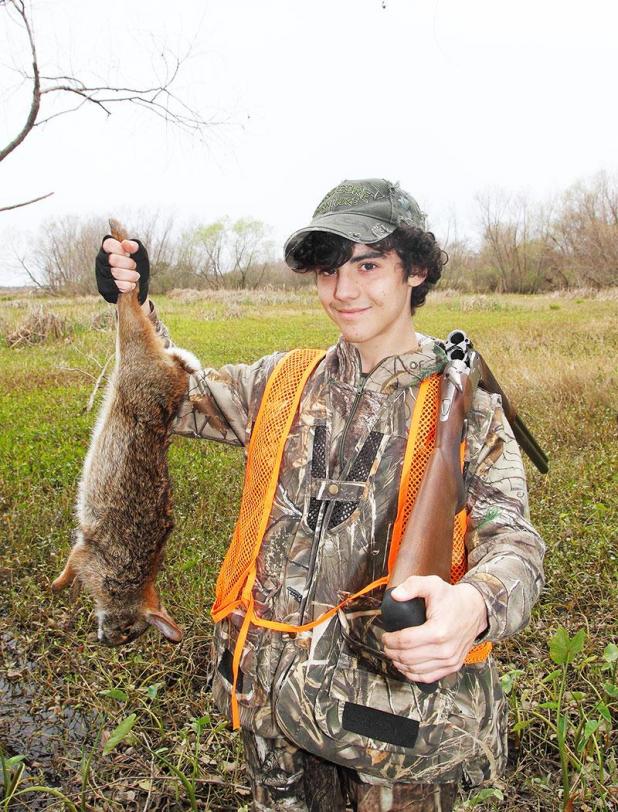
The Daily Review Outdoor Columnist John Flores' grandson, Gabriel Flores, displays a swamp rabbit harvested last season in the St. Mary Parish coastal marsh along a canal bank. The small game season for rabbits and squirrels opens Saturday. (Submitted Photo/Courtesy of John K. Flores)
Small game season opens Saturday
When the first rays of daylight stretch over the coastal marshes and bottomland hardwood swamps Saturday, the 2017 edition of the Louisiana small game season will begin.
The first split of dove season and the special September teal season were just the tune ups.
Of all the various seasons that we hunt during the fall and winter months, including deer, ducks and geese, the small game season, consisting of squirrel and rabbits, runs the longest. In fact, it runs into next year, ending Feb. 28.
When I hit the woods this weekend, it will be my 33rd small game season in the Sportsman’s Paradise. As far as I can remember, the seasons' dates have remained the same annually. You can take to the bank each year that you’re going to be able to legally shoot rabbits and squirrels starting on the first Saturday in October all the way through the last day of February.
It’s been the same with the bag limit, too. The daily limit of eight rabbits and eight squirrels hasn’t changed.
About the only thing that has changed is the overall possession limit, going from a two-day bag limit to three a couple years back.
For the 2017-2018 small game season, it’s going to be the same again this year. And why not? Rabbits and squirrels are some pretty prolific animals.
There are basically two species of squirrels in Louisiana: the gray and the fox squirrel. If you’re into their specific scientific names, they are sciurus carolinensis and sciurus niger, respectively. Both breed twice a year, typically in the spring and late summer, and usually produce three to four young, though larger litters have been recorded.
Additionally, squirrels eat just about anything. Acorns, pecans, hickories, buds, berries, fruits, tubers and bulbs are all part of their diet. They even eat protein like beetles and bird’s eggs. In other words, squirrels aren’t picky eaters.
“We are blessed with some excellent small game populations,” Louisiana Department of Wildlife and Fisheries Small Game Program Manager Cody Cedotal said. “If you have good quality habitat and you get good mast production, you get good reproduction of those species, where hunting becomes compensatory to population levels, per se. That’s why you’ve seen such stable seasons over the years.”
Along the Gulf Coast where I tend to do most of my squirrel hunting, I always look for three food sources: hackberry, wild pecan and water oak trees. Pull into any location canal in the marsh just before daylight where these three tree species exist and you’ll kill a mess of gray squirrels.
In the northern part of the state, I’ve floated the Dugdemona River in Winn Parish for fox squirrels. Seemingly around every bend were these larger red-colored cousins of the gray squirrels I normally hunt, both burying and digging up mast.
It’s much the same with Louisiana’s two species of rabbits, the eastern cottontail and the larger swamp rabbit. Again, if you’re into specific scientific names, they are sylvilagus floridanus sylvilagus aquaticus, respectively.
Rabbits breed from late February into October, with three or four kits per litter being the average. It’s not uncommon for them to have up to six litters, given the opportunity. What’s more, it’s common for their young to have their own litters as they reach sexual maturity in two to three months following birth.
Like squirrels, there is no shortage of food resources for rabbits north to south in Louisiana.
For eastern cottontail rabbits, there’s plenty of grasses, clover, blood weed and other wild plants, as well as agricultural food sources.
For swamp rabbits, there’s a plethora of succulent aquatic vegetation like alligator weed, sedges and cow peas.
In short, with strong reproductive traits and plenty of food sources, is there little wonder things remain the same year in and year out when the Louisiana Department of Wildlife and Fisheries sets season dates and bag limits?
The rabbits’ and squirrels’ lives, though prolific, aren’t a bed of roses. They both are low on the food chain and therefore, are preyed upon by bobcats, coyotes, foxes, raptors snakes and domestic animals. They also are susceptible to severe weather, such as flooding and tropical events.
“Those guys in the lower area of the Atchafalaya Basin have suffered the last couple of years with flooding that has had some short-term impact on rabbit populations,” Cedotal said. “But, typically they’re so efficient at reproducing that they can overcome those impacts quite quickly.”
The most up to date small game harvest data released by the Louisiana Department of Wildlife and Fisheries came from the 2016-2017 season. The annual hunter harvest survey report showed 31,600 rabbit hunters harvested 196,400 rabbits and 89,800 squirrel hunters harvested 1.46 million squirrels last season.
The 2017-2018 small game hunting forecast for rabbits and squirrels this fall is pretty much a repeat of years past. All you have to do starting Saturday is get out and hunt them.
